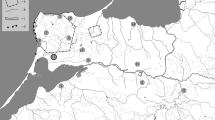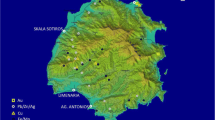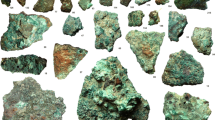Abstract
Numerous metal hoards found in the Friuli-Venezia Giulia plain, Northeastern Italy, are archaeologically dated to the Recent and Final Bronze Age. Here, the results of an archaeometric study of the copper-alloy artifacts and ingots from two such hoards (Cervignano del Friuli and Muscoli, Udine) are presented. The mineralogical, metallographic, and chemical analyses of the copper objects indicate that the metallurgical process employed copper derived almost exclusively from chalcopyrite (±sphalerite, galena) as ore charge. Distinct typologies of ingots (plano-convex and parallel-surfaces) are characterized by different degrees of metal refining. Tools and weapons are made of carefully refined and compositionally controlled bronze alloys, containing specific proportions of tin. These observations point out a high level of technological knowledge in metallic copper extraction and use. The chemical and lead isotope compositions of most analyzed ingots and artifacts suggest exploitation of copper deposits from the Southeastern Alps, including deposits from the Valsugana area and other mining districts of the Trentino-Alto Adige region. One peculiar sample characterized by a significant Sb content suggests possible mixing with “local” fahlerz copper from Carnia and one other ingot, showing a highly radiogenic lead isotope composition may be interpreted as copper from southern Tuscany or as a mixed metal incorporating a small quantity of copper from northerly Alpine sources such as Mitterberg.









Similar content being viewed by others
References
AAcP (2018), Alpine Archaeocopper Project. http://www.geoscienze.unipd.it/aacp/welcome.html (accessed 27 August 2018)
Addis A (2013) Late Bronze Age metallurgy in the Italian Eastern Alps: copper smelting slags and mine exploitation, PhD dissertation, University of Padua
Anelli F (1949) Vestigia protostoriche dell’agro aquileiese. Aquileia Nostra 20:1–24
Angelini I (2005) Le armi della necropoli di Olmo di Nogara: analisi chimiche, metallografiche e microstrutturali. In “La Necropoli dell’Età del Bronzo all’Olmo di Nogara (Verona)”. Collana Memorie del Museo Civico di Storia Naturale di Verona, Sezione Scienze dell’Uomo 8, Verona, pp. 515-527
Angelini A, Angelini I, Artioli G, Nimis P, Villa I (2015) Tipologia e archeometria dei bronzi di Castel de Pedena (San Gregorio nelle Alpi, Belluno). In: Leonardi G., Tinè V. (Eds.), Preistoria e Protostoria del Veneto. Studi di Preistoria e Protostoria 2. Grafiche Antiga, Crocetta del Montello (TV), Italy, 881–866
Artioli G, Angelini I, Tecchiati U, Pedrotti A (2015) Eneolithic copper smelting slags in the Eastern Alps: local patterns of metallurgical exploitation in the Copper Age. J Archaeol Sci 63:78–83. https://doi.org/10.1016/j.jas.2015.08.013
Artioli G, Angelini I, Nimis P, Villa IM (2016) A lead-isotope database of copper ores from the Southeastern Alps: a tool for the investigation of prehistoric copper metallurgy. J Archaeol Sci 75:27–39. https://doi.org/10.1016/j.jas.2016.09.005
Baxter MJ, Beardah CC, Westwood S (2000) Sample size and related issues in the analysis of lead isotope data. J Archaeol Sci 27(10):973–980. https://doi.org/10.1006/jasc.1999.0546
Baxter MJ (2003) Statistics in archaeology. Arnold, London
Belshaw NS, Freedman PA, O’Nions RK, Frank M, Guo Y (1998) A new variable dispersion double–focusing plasma mass spectrometer with performance illustrated for Pb isotopes. Int J Mass Spectrom Ion Process 181:51–58. https://doi.org/10.1016/S1387-3806(98)14150-7
Benvenuti M, Chiarantini L, Norfini L , Casini A, Guideri S, Tanelli G (2003) The “Etruscan tin”: a preliminary contribution from researches at Monte Valerio and Baratti-Populonia (southern Tuscany, Italy), XIVth Congress of the International Union of Prehistoric and Protohistoric Sciences, Vol. 1199, XIVth Congress of the International Union of Prehistoric and Protohistoric Sciences - Liege, Belgio, pp. 55-65, 2-8 Settembre
Bernabò Brea M, Cardarelli A, Cremaschi M (1997) Le Terramare. La più antica civiltà padana. Electa, Milano
Bettelli M, Borgna E, Levi ST (2018) Crisis years and pottery systems. An overview of the Italian Late Bronze Age, in Caloi I., Langohr Ch, eds, Technology in crisis. Technological Changes in ceramic production during periods of trouble, Louvain 2018, pp. 217–240
Bianco Peroni V (1970) Le spade nell’Italia Continentale, PBF IV, 1, Munchen
Bietti Sestieri AM (2010) L’ Italia nell’età del bronzo e del ferro. Dalle palafitte a Romolo (2200-700 a. C.), Carocci Editore, ISBN 8843052071
Borgna E (2001) I ripostigli del Friuli: proposta di seriazione cronologica e di interpretazione funzionale. Rivista di Scienze Preistoriche 51:289–335
Borgna E (2004) I ripostigli del Friuli, in Cocchi Genik D. (Edited by), L’età del Bronzo Recente in Italia. Atti del Congresso Nazionale di Lido di Camaiore, 26-29 ottobre 2000, Viareggio, pp. 90-100
Borgna E (2009) Patterns of bronze circulation and deposition in the Northern Adriatic at the close of the Late Bronze Age, in Borgna E and Cassola Guida P (edited by): From the Aegean to the Adriatic: social organizations, modes of exchange and interaction in postpalatial times (12th-11th B.C.), Quasar Ed., Roma, ISBN 978-88-7140-370-0, pp. 289-310
Borgna E, Cassola Guida P, Mihovilić K, Tasca G, Teržan B (2018a) Il Caput Adriae tra Bronzo Antico e Bronzo Recente, in Preistoria e Protostoria del Caput Adriae, edited by Borgna E, Cassola Guida P, Corazza S, Studi di Preistoria e Protostoria 5, Istituto Italiano di Preistoria e Protostoria, Firenze, pp. 75–95
Borgna E, Cassola Guida P, Corazza S, Mihovilić K, Tasca G, Teržan B, Vitri S (2018b) Il Caput Adriae tra Bronzo finale e antica età del ferro, in Preistoria e Protostoria del Caput Adriae, edited by Borgna E, Cassola Guida P, Corazza S, Studi di Preistoria e Protostoria 5, Istituto Italiano di Preistoria e Protostoria, Firenze, pp. 97–118. Brettscaife.net. http://www.brettscaife.net/ (accessed 27 August 2018)
Canovaro C, Angelini I, Artioli G, Borgna E (2014) Analisi archeometallurgiche di pani e panelle provenienti dai ripostigli di Cervignano e Muscoli (Udine), in Atti del 35° Convegno Nazionale AIM, Roma 5–7 November 2014, ISBN 978-88-98990-01-6
Canovaro C, Angelini I, Borgna E, Artioli G (2018) Analisi chimiche e metallografiche di ripostigli dell’area aquileiese. In: Borgna E, Cassola Guida P, Corazza S (eds) Preistoria e Protostoria del Caput Adriae (Studi di Protostoria 5), Istituto Italiano di Preistoria e protostoria, Firenze, pp 343–354
Carancini GL (1984) Le asce dell’Italia Continentale, II, PBF IX, 12, Munchen
Carancini GL and Peroni R (1999) L’età del bronzo in Italia: per una cronologia della produzione metallurgica, Perugia
Casagrande A, Garagnani GL, Spinedi P, Pellegrini E (1994) Microstructural and analytical characterization of bronze age copper ingots and some metallic artifacts, PACT, 45, II, 7
Cassola P and Vitri S (1997) Gli insediamenti arginati della pianura friulana nell’età del bronzo. In: Le Terramare: La più antica civiltà padana. Modena, Foro Boario, 15 marzo–1 giugno 1997.Milano: Electa
Cierny J, Weisgerber G, Perini R (1992) Ein spätbronzezeitlicher Hüttenplatz in Bedollo/Trentino, vol 8. Universitätsforschungen Prähistorische Archäologie, Bonn, pp 75–82
Cierny J, Hauptmann A, Hohlmann B, Marzatico F, Schröder B, Weisgerber G (1995) Endbronzezeitliche Kupferproduktion im Trentino. Ein Vorbericht, Der Anschnitt, 47/3, Deutsches Bergbau–Museum, Bochum, pp. 82–91
Cierny J (1997) Rame, stagno e bronzo. In: Endrizzi L, Marzatico F (eds) Ori delle Alpi, Catalogo della mostra. Castello del Buonconsiglio, Trento, pp 61–70
Craddock PT (2000) From hearth to furnace: evidences for the earliest metal smelting technologies in the Eastern Mediterranean. In: Paléorient, vol. 26, n°2, La pyrotechnologie à ses débuts. Evolution des premières industries faisant usage du feu, sous la direction de Andreas Hauptmann, pp. 151–165. DOI : https://doi.org/10.3406/paleo.2000.4716
Craddock PT, Meeks ND (1987) Iron in ancient copper. Archaeometry 29(2):187–204
Cupitò M (2006) Tipocronologia del Bronzo medio e recente tra l’Adige e il Mincio sulla base delle evidenze funerarie, Saltuarie dal Laboratorio del Piovego, 7, Padova
De Marinis RC (2011) La Metallurgia a sud delle Alpi. In: Marzatico F, Gebhard R, Gleirscher P (eds) Le Grandi vie delle civiltà. Relazioni fra il Mediterraneo e il Centro Europa dalla Preistoria alla Romanità, Trento, pp 127–135
Girelli D (2013) Panelle, Lingotti e barre. La circolazione delle leghe a base di rame attraverso il Friuli-Venezia Giulia nelle fasi tarde dell’età del bronzo, in Magnani S (Edited by), Le aree montane come frontiere. Spazi di interazione e connettività, Atti del convegno internazionale, Udine 2009, Roma, pp. 569-577
Giumlia-Mair A (2000) Bronze Technology in the Eastern Alpine Regions between the Final Bronze Age and the Early Iron Age. Proceedings of the “Workshop on Ancient Metallurgy between Oriental Alps and Pannonian Plain”, (Giumlia–Mair ed.), 29–30 Ottobre, Dipartimento di Ingegneria dei Materiali e Chimica Applicata, Università di Trieste. Quaderni di Aquileia Nostra, 8, pp. 77–91
Giumlia-Mair A (2003) Iron Age tin in the Oriental Alps. Proceedings of the Colloquium The problems of Early Tin, Giumlia–Mair A and Lo Schiavo F (Eds.), XIV International Congress of Prehistoric and Protohistoric Sciences, Liège, September 2001, Le problème de l’ètain à l’origine de la mètallurgie/ The Problem of Early Tin, BAR International Series 1199, Oxford, pp. 93–108
Giumlia-Mair A (2005) Copper and copper alloys in the Southeastern Alps: an overview. Archaeometry 47(2):275–292. https://doi.org/10.1111/j.1475-4754.2005.00202.x
Giumlia-Mair A (2009) Ancient metallurgical traditions and connections around the Caput Adriae. J Min Metall B 45(2):141–222. https://doi.org/10.2298/JMMB0902149G
Hauptmann A, Maddin R, Prange M (2002) On the structure and composition of copper and tin ingots excavated from the shipwreck of Uluburun. Bull Am Sch Orient Res 328:1–30
Hirata T (1996) Lead isotopic analysis of NIST standard reference materials using multiple collector–inductively coupled plasma mass spectrometry coupled with modified external correction method for mass discrimination effect. Analyst 121:1407–1411. https://doi.org/10.1039/AN9962101407
Hsu YK, Rawson J, Pollard AM, Ma Q, Luo F, Yao PH, Shen CC (2018) Application of kernel density estimates to lead isotope compositions of bronzes from Ningxia, Northwest China. Archaeometry 60:128–143. https://doi.org/10.1111/arcm.12347
Huska A, Powell W, Mitrovic S, Bankoff HA, Bulatovic A, Filipovic V, Boger R (2014) Placer tin ores from Mt. Cer, West Serbia, and their potential exploitation during the Bronze Age. Geoarchaeology: An International Journal 29:477–449
Koppel V and Schroll E (1983) Lead isotopes of paleozoic, stratabound to stratiform galena bearing sulfide deposits of eastern alps (Austria): implications for their geotectonic setting Schweiz Mineral Petrogr Mitt v. 63, pp. 347–360
Koppel V and Weber L (1997) Handbuch der Lagerstätten der Erze, Industrieminerale und Energierohstoffe Österreichs – Erläuterungen zur Metallogenetischen Karte v. Österreich 1 : 500.000 unter Einbeziehung der Industrieminerale u. Energierohstoffe. Arch. f. Lagerst. forsch. Geol. B.–A., 19, Wien, pp. 1–607
Ling J, Stos-Gale Z, Grandin L, Billström K, Hjärthner-Holdar E, Persson PO (2014) Moving metals II: provenancing Scandinavian Bronze Age artefacts by lead isotope and elemental analyses. J Archaeol Sci 41:106–132. https://doi.org/10.1016/j.jas.2013.07.018
Ling J, Hjärthner-Holdar E, Grandin L, Stos-Gale Z, Kristiansen K, Melheim L, Artioli G, Angelini I, Krause R Canovaro C (submitted) Moving metals IV: swords, metal sources and trade networks in Bronze Age Europe, J Archaeol Sci.
Liversage D (1994) Interpreting composition patterns in ancient bronze: the Carpathian Basin. Acta Archaeologica 65:57–134
Maddin R, Wheeler TS, Muhly JD (1980) Distinguishing artifacts made of native copper. J Archaeol Sci 7:211–225
Mangou H, Ioannou PV (2000) Studies of the Late Bronze Age copper–based ingots found in Greece. The Annual of the British School at Athens 95:207–217. https://doi.org/10.1017/S0068245400004640
Marchesetti C (1903) Castellieri preistorici di Trieste e della regione Giulia. Museo civico di Storia naturale, Trieste
Melheim L, Grandin L, Persson PO, Billström K, Stos-Gale Z, Ling J, Williams A, Angelini I, Canovaro C, Hjärthner-Holdar E, Kristiansen K (2018) Moving metals III: possible origins for copper in Bronze Age Denmark based on lead isotopes and geochemistry. J Archaeol Sci 96:85–105. https://doi.org/10.1016/j.jas.2018.04.003
Merkel JF (1983) Summary of experimental results for LBA copper smelting and refining. MASCA J 2:173–178
Nardini A, Canovaro C, Angelini I (in press) Il Ripostiglio di Celò (Pulfero, UD), West & East (Rivista della Scuola Interateneo di Specializzazione in Beni Archeologici, Università di Trieste, Udine, Venezia), Edizioni Università di Trieste, ISSN (online) 2499–7331
Nimis P, Omenetto P, Giunti I, Artioli G, Angelini I (2012) Lead isotope systematics in hydrothermal sulphide deposits from the central–eastern Southalpine (northern Italy). Eur J Mineral 24:23–37. https://doi.org/10.1127/0935-1221/2012/0024-2163
Nimis P, Omenetto P, Stasi G, Canovaro C, Dal Sasso G, Artioli G, Angelini I (2018) Lead isotope systematics in ophiolite associated sulphide deposits from the Western Alps and Northern Apennine (Italy): from oceanisation to metamorphism. Eur J Mineral 30(1):17–31
OXALID (2018), Oxford archaeological lead isotope database. http://oxalid.arch.ox.ac.uk (accessed 27 August 2018)
Pellegrini G (1911) Ripostiglio di oggetti cupro–enei e spada antichissima di bronzo scoperti presso Castions di Strada (Udine). Bullettino di Paletnologia Italiana, 37, Parma, pp. 231–236
Pearce MJ (2004) The Italian Bronze Age. In: Ancient Europe 8000 B.C.-A.D 1000: encyclopedia of the Barbarian world Volume 1: The Mesolithic to Copper Age (c.80002000 B.C.). Ed. by Bogucki P, Crabtree P. New York: Charles Scribner’s Sons, pp. 34–42
Pernicka E and Salzani P (2011) Remarks on the analyses and future prospects. In: A. Aspes (Hrsg.): I bronzi del Garda – Valorizzazione delle collezioni di bronzi preistorici di uno dei più importante centri metallurgici dell’Europa del II° millennio a.C. Memorie del Museo Civico di Storia Naturale di Verona – 2. serie, Sezione delle Scienze dell’Uomo 11, pp. 89–98
Pernicka E, Lutz J, Stoellner T (2016) Bronze Age Copper produced at Mitterberg, Austria, and its distribution. Archaeologia Austriaca 100:19–55
Peroni R and Carancini G (1997) La Koinè metallurgica, in Bernabo Brea M., Cardarelli A., Cremaschi M. (Eds): Terramare la più antica civiltà padana, Modena, pp. 595–601
Pigorini L (1904) Ripostigli di bronzi arcaici nell’Italia austriaca, Bullettino di Paletnologia Italiana, nr 3, pp. 138–142
Pigorini L (1895) Antichi pani di rame e di bronzo da fondere rinvenuti in Italia. Bullettino di Paletnologia italiana 21:5–38
Preuschen E (1973) Estrazione mineraria dell’Età del Bronzo nel Trentino. Preistoria Alpina – Rendiconti 9:113–150
Rapp GR (2013) Archaeomineralogy. Media, Springer Science & Business
Rehkamper M, Halliday AM (1998) Accuracy and long–term reproducibility of lead isotopic measurements by MC–ICP–MS using an external method for correction of mass discrimination. Int J Mass Spectrom Ion Process 58:123–133. https://doi.org/10.1016/S1387-3806(98)14170-2
Rehkämper M, Mezger K (2000) Investigation of matrix effects for Pb isotope ratio measurements by multiple collector ICP–MS: verification and application of optimized analytical protocols. J Anal Atom Spectrom 15(11):1451–1460. https://doi.org/10.1039/b005262k
Sabatini BJ (2015) The As-Cu-Ni system: a chemical thermodynamic model for ancient recycling. JOM 67(12):2984–2992. https://doi.org/10.1007/s11837-015-1593-3
Scaife B, Budd P, McDonnell JG, Pollard AM (1999) Lead isotope analysis, oxide ingots and the presentation of scientific data in archaeology. In metals in antiquity, eds. Young, S. M. M., Pollard, A. M., Budd, P., and Ixer, R. A. F., BAR International Series 792, Oxford, Archaeopress, pp. 122–133
Scott DA (2012) Ancient metals: microstructure and metallurgy volume 1. Copper and copper alloys. CSP: Conservation Science Press
Simeoni G, Corazza S (2011) Di terra e di ghiaia, Tumuli e Castellieri del Medio Friuli tra Europa ed. Adriatico, La Grame
Stos ZA (2009) Across the wine dark seas. Sailor tinkers and royal cargoes in the Late Bronze Age eastern Mediterranean. In: Shortland AJ, Freestone IC, Rehren T (eds) From mine to microscope e advances in the study of ancient technology. Oxbow Books, Oxford, pp 163–180
Stos-Gale ZA, Gale NH (2009) Metal provenancing using isotopes and the Oxford archaeological lead isotope database (OXALID). Archaeol Anthropol Sci 1:195–213. https://doi.org/10.1007/s12520-009-0011-6
Tasca G (2011) Tipologia e cronologia della produzione ceramica del Bronzo medio-recente nella Bassa Pianura Friulana, PhD dissertation, University of Padua
Tuniz C, Confalonieri L, Milazzo M, Monichino M, Katsanos A (1986–87) Uso di tecniche atomiche e nucleari per lo studio archeologico di antichi oggetti metallici. Bollettino della Società Adriatica di Scienze 69:17–27
Turk P (1996) The dating of Late Bronze Age hoards, in Terzan B., Hoards and individual metal finds from the eneolithic and Bronze Ages in Slovenia II, Ljubljana
Tylecote RF (1981) International archaeological symposium: early metallurgy in Cyprus 4000–500 BC, Cyprus, p. 81
Tylecote RF (1992) A history of metallurgy (2nd edition). The Metals Society, London
Tylecote RF, Ghaznavi HA, Boydell PJ (1977) Partitioning of trace elements between the ores, fluxes, slags and metal during the smelting of copper. J Archaeol Sci 4:305–333
Villa IM (2009) Lead isotopic measurements in archeological objects. Archaeol Anthropol Sci 1(3):149–153
Vitri S (1983) La raccolta preistorica del Museo di Aquileia, In: I Musei di Aquileia 1, pp. 117-126
Vitri S (1984) Cervignano (Udine), Aquileia Nostra, nr 55, pp. 268–269
Vitri S (1990) Carte archeologiche e schede di sito, in Desinan CC. Toponomastica e archeologia del Friuli prelatino con note di aggiornamento di protostoria friulana, Pordenone, pp 158–174
Vitri S (1991) Cervignano (via Lazzaro). Relazioni della Soprintendenza per i beni AAAAS del Friuli-Venezia Giulia 8:130–133
Vitri S (1999) Nuovi ritrovamenti di Bronzi protostorici in Friuli. Contributo alla definizione del ruolo del Caput Adriae nell’Età del Bronzo Finale AN LXX:289–296
White WM, Albarède F, Télouk P (2000) High–precision analysis of Pb isotope ratios by multi–collector ICP–MS. Chem Geol 167(3–4):257–270. https://doi.org/10.1016/S0009-2541(99)00182-5
Zucchini R (1998) Miniere e mineralizzazioni nella provincia di Udine. Aspetti storici e mineralogici, Edizioni del Museo Friulano di Storia Naturale, Udine
Acknowledgements
The project benefited from the collaboration with the Soprintendenza Archeologia, Belle Arti e Paesaggio of Friuli-Venezia Giulia and with the Museo Archeologico Nazionale of Aquileia. In particular, we are grateful to Dr. Roberto Michieli who kindly made the materials available for this study. We wish to thank in particular Dr. Paola Ventura, director of the Museum of Aquileia, and Daniele Pasini for the technical support received during the sampling step. We are also thankful to I.M. Villa for his help and support during isotopic analysis.
Funding
The authors acknowledge financial support by Progetto di Ateneo 2013 CPDA138741 “Copper metallogenesis and provenancing in the Alpine realm” (University of Padua).
Author information
Authors and Affiliations
Corresponding author
Additional information
Publisher’s note
Springer Nature remains neutral with regard to jurisdictional claims in published maps and institutional affiliations.
Rights and permissions
About this article
Cite this article
Canovaro, C., Angelini, I., Artioli, G. et al. Metal flow in the late Bronze Age across the Friuli-Venezia Giulia plain (Italy): new insights on Cervignano and Muscoli hoards by chemical and isotopic investigations. Archaeol Anthropol Sci 11, 4829–4846 (2019). https://doi.org/10.1007/s12520-019-00827-2
Received:
Accepted:
Published:
Issue Date:
DOI: https://doi.org/10.1007/s12520-019-00827-2




